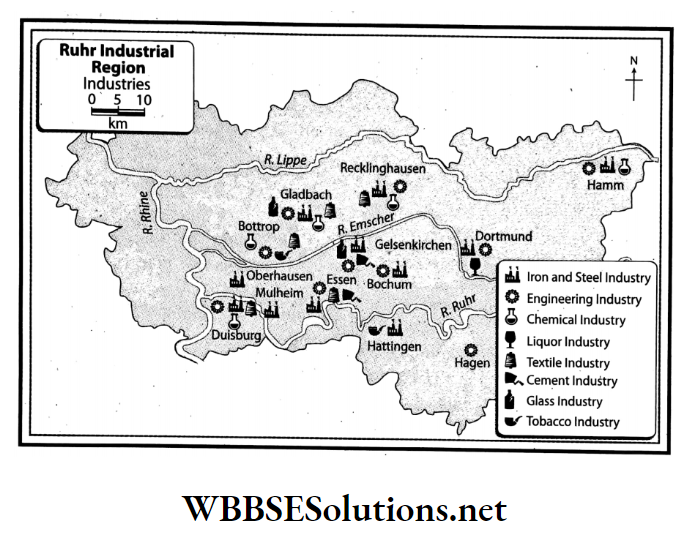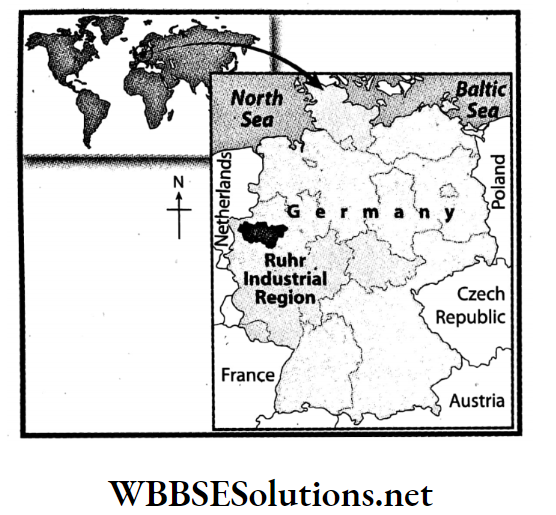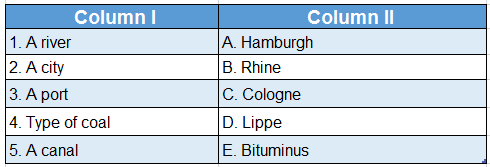Chapter 11 Topic B Ruhr Industrial Region Analytical Type Questions
Question 1. Describe the physical environment of the Ruhr Industrial Region.
Answer:
The physical environment of Rurh Industrial Region:
Physical environment of the Ruhr Industrial Region is as follows-
1. Physiography:
The topography of the Ruhr Industrial Region is almost flat. Occasional hillocks are found. The average elevation of this region is approximately 240 metres. To the east of this area lies the Sayerland Highlands. This region has a general slope from east to west.
2. River:
The Rhine is the main river of this region. This river flows along the western boundary of the Ruhr region after entering this region near the city of Cologne. Lippe and Ruhr are the other important rivers of this region.
WBBSE Solutions For Class 7 Geography
These two rivers flow from the east and then drain into the river Rhine. The rivers are well connected by canals and are navigable throughout the year.
3. Climate:
The climate of the Ruhr region is of cool temperate type. Due to the influence of westerlies, rainfall occurs throughout the year. The amount of annual rainfall is 50- 70 cm. The average summer temperature is 15°C-20°C and the average winter temperature ranges between 2°C to 5°C.
4. Natural Vegetation:
The area of forestland has decreased due to agriculture, urbanisation and industrialisation. However, coniferous trees like oak, birch, pine etc. can be seen in some places. Some deserve and planted forests have been planted to reduce the pollution of the industrial region.
Question 2. Describe the economic environment of the Ruhr Industrial Region.
Answer:
The economic environment of Rurh Industrial Region:
The economic environment of the Ruhr Industrial Region can be described as below-
1. Agriculture and animal husbandry:
Since the region is mainly an industrial area, both the production and importance of agriculture is less here. Mixed farming is practised in this region.
Wheat, barley, oats, maize, various fruits and flowers are cultivated here. Animal husbandry is practised to produce meat and milk.
2. Mineral resources:
The Ruhr region is rich in mineral resources. Coal is the main mineral here. Excellent quality of anthracite and bituminous coal is available here. In addition, petroleum is found in some places.
3. Industry:
The Ruhr region is one of the best-industrialised regions of Europe. Iron and steel is the main industry here. Duisburg, Gelsenkirchen, Essen and other places are famous for the iron and steel industry.
In addition, the engineering industry, chemical industry, textile industry, electrical industry, cement, glass, food processing etc. also have developed here.
4. Settlement:
Ruhr region is industrially developed. Transportation facilities are also good. So this region is densely populated. The settlement is mainly centred around the industrial area.
Question 3. Describe the factors behind the development of the Ruhr Industrial Area.
Answer:
Favourable factors for the development of the Rurh Industrial Region:
The factors behind the growth and development of the Ruhr Industrial Area are as follows-
1. Availability of coal:
High coal reserves are available in a vast expanse in the region lying between the rivers Rhine, Lippe and Ruhr. The Westphalia region also has a large reserve of premium-grade anthracite and bituminous coal that is used in the Ruhr Industrial Area.
2. Availability of iron ore:
Iron is imported through both waterways and roadways to this region from the nearby countries of Sweden, France, Luxemburg and Spain.
3. Easy availability of labour:
This region is well-populated and well-developed in education and vocational training as well. As a result, there is a steady supply of skilled labour. Moreover, the climate is favourable for the development of the industrial region.
4. Well-developed transport facility:
The entire region is well connected by roadways, railways and waterways. The northern part of Germany has the famous Hamburg port.
5. Abundant availability of soft water:
The water from Rhine, Ruhr, and Lippe is used in these industries.
6. Advanced technology:
The use of advanced technology has aided in developing both the quality and quantity of the products manufactured in this region.
Apart from this, substantial investments from industrialists, the locational advantages of this area, and the demand for the finished goods of this region in the international market are all factors that have helped in the growth and development of this region.
Question 4. Name the various industrial centres of the Ruhr Industrial Region.
Answer:
Various industrial centres of Rurh Industrial Region:
The various industries and its location are described as follows-
1. Iron and steel industry
Industrial centres:
- Duisburg,
- Mulheim,
- Essen (Krups and Demag Company
- Dortmund,
- Oberhausen,
- Geilsen-kersen,
- Bochum,
- Hamm,
- Reck-linghausen,
- Hattingen and such others.
Products: Steel is, the main product of the iron and Steel companies.
2. Engineering industry
Industrial centres:
- Dortmund,
- Bochum,
- Essen,
- Gelsenkirchen,
- Duisburg,
- Bottrop,
- Hamm,
- Reck-linghausen,
- Gladbach,
- Hagen and such others.
Products:
Rail engines, rail compartments, mining instruments, instruments of paper mills, and such other instruments used in various industries.
3. Chemical industry
Industrial centres:
- Duisburg,
- Hamm,
- Bottrop,
- Recklinghausen,
- Gladbach and such others.
Products: Colours, medicine, bleaching powder, pesticides, and explosives are the main product of the chemical industry.
4. Liquor industry
Industrial centre: Dortmund.
Products: Liquors in the main product of these industry.
5. Textile industry
Industrial centres:
- Essen,
- Monchen gladbach,
- Akhen,
- Kleinfeld,
- Bottrop,
- Recklinghausen,
- Duisburgand such others.
Products: Cotton clothes, woollen clothes, silk clothes and such others are the main product of the textile industry.
6. Cement industry
Industrial centres:
- Gelsenkirchen,
- Essen and such others.
Products: Cement is produced here.
7. Glass industry
Industrial centres: Gelsenkirchen.
Products: Household and equipment are produced in this industry.
8. Tobacco industry
Industrial centres:
- Bottrop,
- Hattingen and such others.
Products: Cigarettes and cigars are produced in this industry.

Chapter 11 Topic B Ruhr Industrial Region Short Analytical Type Questions
Question 1. Describe the topography of the Ruhr region in Germany.
Answer:
The salient points of the topography of the Ruhr region are as follows-
- The average elevation of this plainland is about 240 metres above sea level.
- The region slopes from east to west.
- This region has been formed by the deposition of glaciers and rivers.
- There are some hillocks made of rocks, pebbles and sand in this region which were formed in the Ice Age by the erosional and depositional activities of glaciers.
- Sayerland Highland is situated to the east of the Ruhr Industrial Region.
- The physiography of this region is slightly undulating.
Question 2. Write about the location and area of the Ruhr region.
Answer:
Location:
The Ruhr Industrial Region is located at the confluence of the Rhine, Ruhr and Lippe rivers. Its east-west extent is larger than its north-south stretch.
Boundary:
To the east of this industrial area lies the Sayerland Highlands, to the west is the river Rhine, to the north boundary is the Lippe River and to the south is river Ruhr.
Area: The total area of this region is about 4,600 sq km.

Question 3. Describe the main river flowing through the Ruhr Industrial Region.
Answer:
Main river flowing through the Ruhr Industrial Region:
The main river of the Ruhr Industrial Region is the Rhine.
This river enters Ruhr Industrial Region near the city of Cologne in the south and then flows along the western boundary of this region.
The main tributaries of the river Rhine are the Ruhr and the Lippe. The rivers Ruhr and Lippe flow towards the east and meet the course of the river Rhine.
Question 4. Describe the soils of the Ruhr Industrial Region.
Answer:
There are mainly three types of soils found in the Ruhr Industrial Region, namely-
- Fertile alluvial soil: Fertile alluvial soils are found along the river banks of the Rhine and its tributaries.
- Chernozem soil: Fertile black-coloured chernozem soils are found in the southern parts of this region.
- Podzol soil: In the north of this region, less fertile grey podzol soils are found.
Question 5. What are the main mineral resources of the Ruhr Industrial Region?
Answer:
Main mineral resources of the Ruhr Industrial Region:
The main mineral resource of the Ruhr Industrial Region is coal. This area has reserves of about 5000 million metric tonnes of coal. Presently, it is from this area that 80 per cent of Germany’s coal is extracted.
Most of this is premium-grade bituminous coal. Some parts of this area yield even the super-premium anthracite variety also. The main coal mining area is enclosed by the river Rhine, Lippe and Ruhr. Apart from this, petroleum is also mined in some places.
Question 6 Discuss the iron extraction and steel-producing centres of the Ruhr Industrial Area.
Answer:
Iron extraction and steel-producing centres of the Ruhr Industrial Area
In the Ruhr Industrial Region, the centres for the extraction of raw or pig iron are near the rivers and the steel factories have been established near the canals.
Huge barges heavy with iron ore travel up the waterways and deliver the iron ore to the iron extraction centres.
Then the pig iron extracted in these factories are transported to the large steel-producing centres in the interior of the region such as Essen, Mulheim, Gelsenkirchen, Dortmund, Oberhausen, Bokhum the interior by the Lippe Canal waterway and the Rhine-Herne- Dortmund Canal waterway.
Question 7. Discuss the transport network of the Ruhr Industrial Region. Or, Mention the role of the transport network in the economic development of the Ruhr Industrial Region.
Answer:
The transport system in the Ruhr Industrial Region is extremely well-developed. The rail and road networks are both extensive and intensive and crisscross the entire area.
1. Railways:
This industrial area is located on the main railway line that extends from the east to the west of the continent and so, it is easy to maintain trade with Spain, Portugal, Belgium, France and other countries.
2. Waterways:
The waterways i.e. inland water network is also well-developed in this region. The rivers Rhine, Ruhr and Lippe flow through this region and remain easily navigable throughout the year.
The rivers are again connected to each other through canals like the Rhine-Herne, Dortmund-Ems and Lippe canals. As a result, one can reach the sea even from places in the interiors of this region.
3. Airways:
The big cities in this area are also connected by air.
Question 8. What is meant by mixed farming?
Answer:
Mixed farming:
An agrarian system that combines arable farming with the raising of livestock is known as mixed farming. In this system, farms grow crops. and are also involved in other agriculture-based practices like dairy farming, poultry or beekeeping.
This has generally been practised in regions where population density is high and thus the pressure on the land is high. Traditionally, mixed farming has been the dominant type of agriculture in Europe.
While this had been historically developed for purposes of self- consumption. In the polders in Europe, now this type of farming is also undertaken for commercial purposes, especially in regions
where the pressure on land is high because of high population density.
Chapter 11 Topic B Ruhr Industrial Region Short Answer Type Questions
Question 1. Where is the Ruhr Industrial Region located?
Answer: Ruhr Industrial Region is located in the country of Germany of Europe. At the confluence of the Rhine and its two tributaries-Ruhr and Lippe, this industrial region has developed around coal mines.
Question 2. Mention some major cities of the Ruhr Industrial Region.
Answer: Some major cities of the Ruhr Industrial Region are-Duisbergh, Essen, Geilsenkersen, Gladbeach, Dusseldorf, Dortmund, Ham etc. Dortmund is the largest city and riverine part here.
Question 3. What is the nature of the climate of the Ruhr Industrial Region?
Answer: The climate of the Ruhr region in Germany is of the cold temperate type. Summer temperature is moderate and winters are cold. In summer, the average temperature is about 15°C to 20°C and in winter, it is between 2°C to -5°C.
In winter, snowfall sometimes occurs. This region experiences rainfall throughout the year due to westerlies. The annual average rainfall is 50 cm-75 cm.
Question 4. What do you know about agriculture in the Ruhr region?
Answer: The Ruhr region is primarily an industrial zone and so, agriculture is practised only in order to meet the needs of the inhabitants of the cities in this area. Mixed farming is practiced in this region.
Small quantities of wheat, job, rye, oats, potatoes, maize, animal fodder as well as different kinds of greens and vegetables, fruits and flowers are cultivated here. Apart from this, livestock is also reared.
Question 5. What are the requirements for setting up an industry in any place?
Answer: The main requirements for setting up an industry in any place are-land, raw materials, water, labour, affordable transport, energy resources, capital, market, favourable government policy etc.
Chapter 11 Topic B Ruhr Industrial Region Multiple Choice Questions Choose The Correct Option
Question 1. The largest industrial region of Europe is-
- London
- Polderland
- Ruhr
Answer: 3. Ruhr
Question 2. The Ruhr Valley is a famous-
- Industrial region
- Climatic zone
- Grassland
Answer: 1. Industrial region
Question 3. The Ruhr region is situated in –
- British Isles
- France
- Germany
Answer: 3. Germany
Question 4. To the north of the Ruhr region lies the-
- Hamburg port
- London port
- Lyon port
Answer: 1. Hamburg port
Question 5. The main river of the Ruhr Industrial Area is the-
- Rhine
- Ruhr
- Volga
Answer: 1. Rhine
Question 6. One of the main rivers of the Ruhr Industrial Region is-
- Lippe
- Kiev
- Erie
Answer: 1. Lippe
Question 7. The main agricultural system that is practised in the Ruhr Industrial Region is-
- Truck farming
- Mixed farming
- Plantation
Answer: 2. Mixed farming
Question 8. The main coal mine in the Ruhr Valley is-
- Detroit
- Duluth
- Westphalia
Answer: 3. Westphalia
Question 9. The main industry in the Ruhr region is-
- Chemical industry
- Engineering industry
- Iron and steel industry
Answer: 3. Iron and steel industry
Question 10. The main mineral resource of the Ruhr region is-
- Coal
- Iron Ore
- Manganese
Answer: 1. Coal
Question 11. The main industry in the city of Duisburg is-
- Chemical industry
- Textile industry
- Iron and steel industry
Answer: 3. Iron and steel industry
Chapter 11 Topic B Ruhr Industrial Region Very Short Answer Type Questions Fill In The Blanks
Question 1. The main river of the Ruhr Industrial Region is the _________.
Answer: Rhine
Question 2. The rivers of the Ruhr region are connected to each other through _________.
Answer: Canals
Question 3. In the south of the Ruhr Industrial Region, _________ soil is found.
Answer: Chernozem
Question 4. Anthracite and _________ coal is found in the Ruhr region.
Answer: Bituminous
Question 5. _________ is the largest exporting port of London Basin.
Answer: London
Question 6. _________ is famous for the manufacture of knives and scissors.
Answer: Solingen
Chapter 11 Topic B Ruhr Industrial Region Write True Or False
Question 1. Essen is the largest city in Europe.
Answer: False
Question 2. The main mineral resource of the Ruhr region is iron ore.
Answer: False
Question 3. The main industry of the Ruhr region is iron and steel.
Answer: True
Question 4. The Ruhr Industrial Region has developed in the Rhine-Ruhr river basin.
Answer: True
Question 5. The Rhine is the busiest inland waterway of Europe.
Answer: True
Question 6. The main coal mine of the Ruhr industrial region is Westphalia.
Answer: True
Chapter 11 Topic B Ruhr Industrial Region Match The Columns
1.
Answer: 1. B, 2. C, 3. A, 4. E, 5. D
Chapter 11 Topic B Ruhr Industrial Region Answer In One Or Two Words
Question 1. Which industrial region has developed at the confluence of rivers the Rhine and the Ruhr?
Answer: The Ruhr Industrial Region.
Question 2. What is the approximate area of the Ruhr Industrial Region?
Answer: About 4,600 sq km.
Question 3. What is the main canal of the Ruhr region?
Answer: Lippe canal.
Question 4. What are the rivers that drain the Ruhr region?
Answer: Rhine, Ruhr, Lippe and Emscher.
Question 5. What kind of coals are available in the Ruhr region?
Answer: Anthracite and Bituminous.
Question 6. Name an important centre of the iron and steel industry in the Ruhr Industrial Region.
Answer: Essen.
Question 7. Is the Hamburgh port located within the Ruhr region?
Answer: No.

